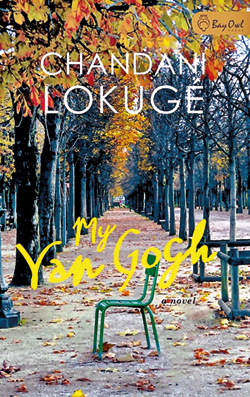A pilgrimage of the self through the tortured mind of a young artist
View(s): “How easy it would be, he thought. The splash, the swirl of water closing over him.”
“How easy it would be, he thought. The splash, the swirl of water closing over him.”
These are the thoughts of Shannon, a young man on the brink of suicide, whose journey to a safer sense of self and psychological well-being make up the fabric of Chandani Lokugé’s new novel, My Van Gogh (2020). Abandoned by a mother to whose ghost he remains unconditionally devoted, Shannon leaves his home in Australia on a journey to his mother’s native land, France, where he traces the final footsteps of the great impressionist painter Vincent Van Gogh. The painter, famously known for his struggles with depression and psychosis, ultimately succumbed (or was liberated, depending on how you read Van Gogh’s suicide) to the chronic mental health issues that he was forced to live with. Shannon’s fascination with Van Gogh becomes a prism through which he views his own life, his own struggle to stay alive, to create, and to seek answers to the questions of consuming loss and doubt that dog him all his life.
Shannon’s journey from Australia to France is, in every sense, a pilgrimage. While centered on Shannon’s journey, the novel is as much about the characters he encounters along the way, as it is about their stories; each voice rises, interacts, builds, and becomes one more thread in the fabric of the narrative. Lokugé seems to gesture in form and setting to the medieval pilgrims’ tales of which Geoffrey Chaucer’s The Canterbury Tales (1400) is the most iconic example in the English language (and has shaped the English language we speak today). Each character has a preoccupation, is on a promised journey, and the stories they narrate give form to their individual journeys. The tenor of Lokugé’s novel, which has a probing, melancholy lilt, is one of deep introspection and despair, momentarily eased by glimpses of release or redemption that often take the form of artistic expression. But there is a single thread that unites all these stories, and that is each character’s struggle to cope with trauma.
European frame narratives, which were the genre convention for The Canterbury Tales, were a form of storytelling that emerged in the aftermath of the Bubonic plague, a strange coincidence that does not escape this reader in the era of the COVID-19 global pandemic. However, Lokugé’s novel deals with a different, invisible pandemic, which has reared its ugly head among youth with increasing frequency—the growing global crisis in mental health among youth that has swept through all parts of the world in the past decade. The novel’s characters are all young, and already fractured. They struggle with a despair that is at once personal and systemic. Their aggregate need to erase the self through work, or sex, or art, or death, is a stark reminder of the collective despair felt by a generation whose future has already been stolen. How does a young person respond to a future that promises nothing, to circumstances that are now “always already” too devastating to negotiate, except with anxiety and despair? Though Lokugé’s characters appear consumed by personal traumas, the collective insistence of trauma forms a link between these separate lives, and points squarely to the alienation of a generation that has been failed by circumstance. This is perhaps most forcibly brought home by a tragic and violent accident that opens the book, a senseless loss, that is just one among many.
At heart, the novel probes the capacity of art to be a corrective to trauma, and is conventionally a Künstlerroman, a novel that tells the coming-of-age narrative of an artist. Shannon, an erstwhile art student, seeks answers and meaning in Van Gogh’s descent into madness, following the artist’s tragic choice between the numbness of sanity that would deny him his art, and the unstable creative genius that would give us his masterpieces. Lilou, a beautiful young woman whose path crosses with Shannon, tries to rise above the trauma of sexual assault, and the resulting death of a loved one, through heart-breaking sketches of birds trying to fly. With each struggle and stumble, Shannon and Lilou inch their way forward on their path to atonement, demonstrating the tremendous resilience of the human psyche to heal through creative exploration and expression. The characters that Shannon and Lilou gather along the way become an eccentric, chosen family, each bringing an added nuance of human relationship that begins to reform their fragmented selves, and provides an emerging sense of community, and wholeness.
Unlike Lokugé’s prior works of fiction, this novel has nothing to do with Sri Lanka. As such, it signals a departure from the diasporic thematics of expatriation that have been the central preoccupations of her prior works. And yet, the central issue of a young person’s struggle to overcome the paralyzing forces of inner darkness has deep resonance because it is just such a psychological landscape that cannot be contained by the specific contingencies of nation or history, but is shaped by our shared human response to trauma. This novel does not have to be about colonization, or nation, or post-independence struggles; it offers an invitation to the Lankan reader to step beyond the ethnopolitical boundaries that shape so much of our literature, to dive into something that we could perhaps call the “human condition”, as unfashionable as that might be.
Lokugé’s novel invites us to participate in a journey in which each painful and terrifying step is a pilgrimage of the self; and in the tortured mind of the young artist, this journey is perhaps the only way to contain the sublime face of trauma within the beautiful.
| Book facts | |
| My Van Gogh by Chandani Lokugé Bay Owl Press, 2020 Priced at Rs 1100, in all major bookshops Reviewed by Aparna Halpé |


